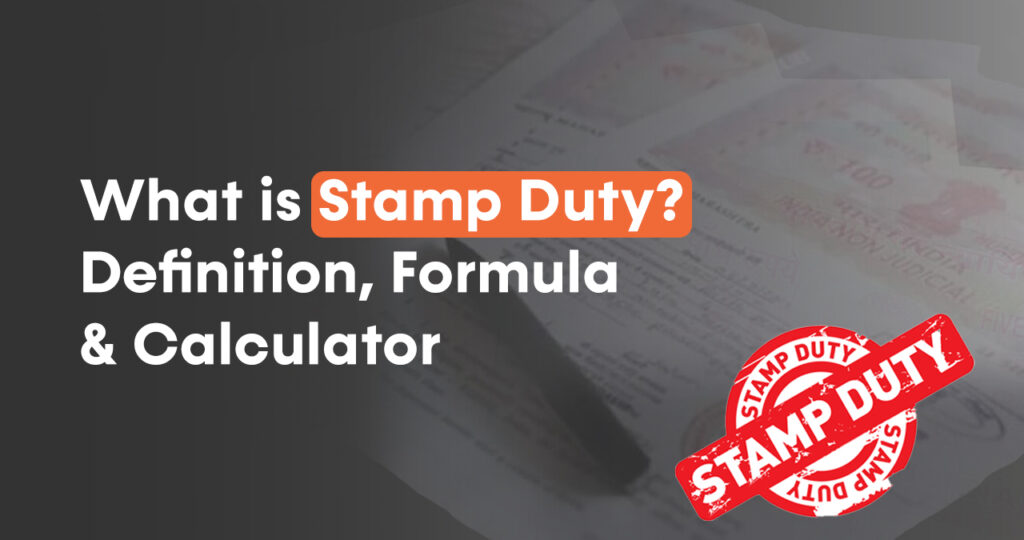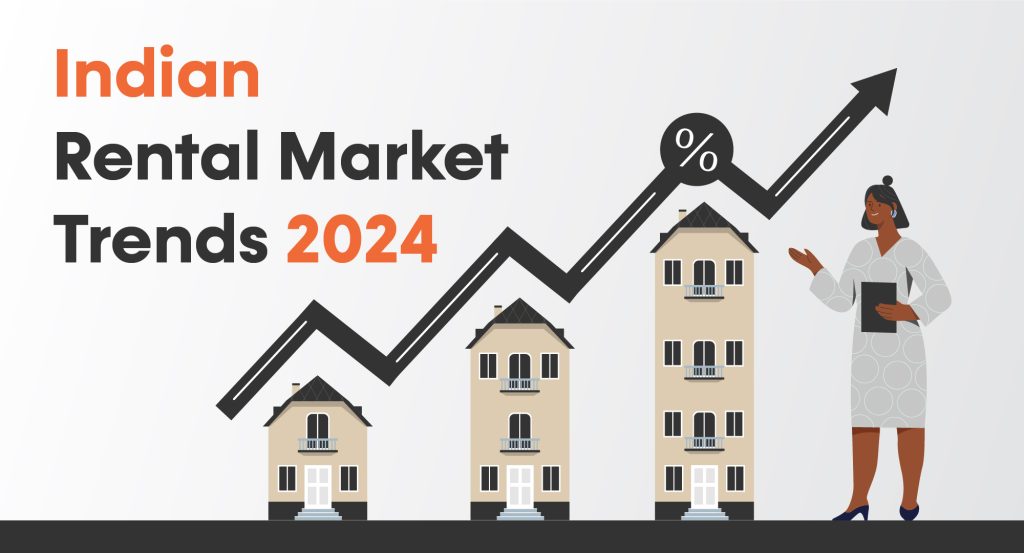Under the Indian Stamp Act of 1899, stamp duty is defined as a tax levied on specific legal documents, primarily those involved in property transactions. It ensures that agreements, such as a sale deed between a buyer and seller, are officially validated. The amount payable is determined by the state government and varies based on factors like property value, location, and buyer demographics.
In practical terms, stamp duty is a percentage of the property’s market value or circle rate (the government-assessed minimum value), whichever is higher. Once paid, the document is stamped—either physically or electronically—confirming its legal status.
Stamp Duty Formula
![]()
Stamp Duty Calculator
Stamp Duty Calculator
Sample Stamp Duty Rates by State
Here’s an indicative list of stamp duty rates across major Indian states (as of 2025, subject to change):
| State | Stamp Duty Rate |
| Maharashtra | 6% |
| Delhi | 6% (4% for women) |
| Karnataka | 5% |
| Tamil Nadu | 7% |
| Uttar Pradesh | 7% |
| Haryana | 7% (5% for women) |
| Gujarat | 4.9% |
Disclaimer: The stamp duty rates may vary by state, city, property type, and buyer category (e.g., female, senior citizen). Government policies are subject to change without prior notice. We recommend verifying the current rates with your local authority or official government website before making any financial decisions.
Factors Affecting Stamp Duty Rates
Several variables influence the stamp duty rate:
- Location: Urban areas often have higher rates than rural ones due to elevated property values.
- Property Type: Commercial properties typically incur higher stamp duty than residential ones.
- Buyer’s Gender: States like Delhi reduce rates for female buyers (e.g., 4% vs. 6% for men).
- Buyer’s Age: Senior citizens may qualify for concessions in some states.
- Property Use: Residential properties usually have lower rates than commercial or industrial ones.
Why is Stamp Duty Important?
Paying stamp duty is more than a financial obligation—it’s a legal necessity. Here’s why it matters:
- Legal Ownership: Without stamp duty payment, property registration is incomplete, meaning the buyer isn’t the legal owner.
- Evidence in Court: The stamped document is a legally recognized record of the transaction.
- Revenue for States: Stamp duty contributes significantly to state government funds, supporting public infrastructure and services.
Failure to pay can lead to penalties or render the property document invalid, making it critical for buyers to understand and comply with this requirement.
What is Stamp Duty in India?
Stamp duty is a mandatory tax imposed by state governments in India on property transactions, governed by the Indian Stamp Act of 1899. It is a one-time payment based on the property’s value, paid during the registration process to legalize the transfer of ownership. The stamped document—whether a sale deed, lease agreement, or mortgage deed—serves as legal proof of the transaction and can be presented in court if disputes arise.
The term “stamp duty” comes from the historical practice of affixing a stamp on documents to signify tax payment. Today, this tax applies to various property-related dealings, including residential and commercial purchases. It differs from other taxes like GST, which may apply to under-construction properties, as stamp duty focuses solely on the legal transfer of ownership.
How to Pay Stamp Duty
India offers multiple payment methods, varying by state:
- Physical Stamp Paper: Buyers purchase stamp paper from authorized vendors and print the document on it.
- E-Stamping: Online payment through state portals generates an e-stamp certificate, widely adopted for convenience.
- Authorized Banks: Payments can be made at designated banks, with a receipt issued for registration.
- Franking: Some states allow payment via franking machines at banks or post offices, marking the document as paid.
Online methods are increasingly popular, streamlining the process. Buyers should confirm the accepted method in their state.
Registration Charges: A Companion Cost
Alongside stamp duty, registration charges are required to finalize property registration. Typically set at 1% of the property value, these fees cover the administrative cost of recording the transaction in government records.
Exemptions and Rebates on Stamp Duty
Certain buyers or properties qualify for reduced rates:
- Women Buyers: Delhi (4%), Haryana (5%), and others incentivize female ownership.
- Senior Citizens: Some states offer concessions for those over 60.
- Agricultural Land: Lower rates apply compared to urban properties.
- First-Time Buyers: Rebates exist in select states to encourage homeownership.
Check state-specific policies to see if you qualify.
Recent Updates in Stamp Duty
Economic conditions often prompt rate changes. For instance, Madhya Pradesh cut stamp duty by 2% in 2020 to boost real estate post-COVID. Buyers should monitor such updates for potential savings.
Conclusion
Stamp duty is a vital tax in India’s real estate market, ensuring legal property ownership. By understanding its calculation, payment options, and available rebates, buyers can plan effectively. Use a stamp duty calculator for estimates, but always consult local authorities for precision. Paying stamp duty isn’t just compliance—it’s the key to securing your property rights. If you want to buy a property in Chandigarh Tricity, you can explore Lets Rentz for zero brokerage properties.
Frequently Asked Questions (FAQs)
What happens if I don’t pay stamp duty?
Failure to pay stamp duty renders the property document invalid, meaning the transaction isn’t legally recognized. This can prevent you from claiming ownership and lead to penalties, typically 2% per month of the unpaid amount, capped at 200% in some states.
Can stamp duty be paid online?
Yes, most states offer e-stamping facilities through portals like SHCIL (Stock Holding Corporation of India Limited) or state-specific websites. Buyers can generate an e-stamp certificate after online payment, which is widely accepted for registration.
Is stamp duty the same for all property types?
No, stamp duty rates vary based on property type. Residential properties generally have lower rates than commercial or industrial ones. For example, commercial properties in Maharashtra may incur an additional surcharge.
Are there any tax benefits on stamp duty?
Stamp duty is not directly deductible under income tax laws. However, under Section 80C of the Income Tax Act, 1961, home loan borrowers can claim deductions on registration charges and stamp duty (up to ₹1.5 lakh) if the property is self-occupied.
How do I find the circle rate for my property?
Circle rates are published by state governments and available at sub-registrar offices, revenue department websites, or real estate portals. They vary by locality and property type, so check with your local authority for accuracy.
Can I get a refund on stamp duty?
Refunds are rare but possible in specific cases, such as if the property transaction is canceled and the document isn’t executed. You must apply to the state’s revenue department within a stipulated period (usually 6 months).
Does stamp duty apply to gifted properties?
Yes, stamp duty applies to gifted properties, but rates are often lower. For instance, in Maharashtra, stamp duty on property gifted to family members (e.g., spouse, children) is ₹200 or a nominal percentage.
How often do stamp duty rates change?
Rates are revised periodically based on state government policies, economic conditions, or real estate market trends. Check with your state’s revenue department or sub-registrar office for the latest rates.
Is stamp duty applicable on under-construction properties?
Stamp duty applies only during the registration of the final sale deed. For under-construction properties, buyers typically pay stamp duty at possession or completion, based on the final agreement value.
Can I use a stamp duty calculator for all states?
Most online calculators cover major states but may not account for recent changes or local surcharges. Always verify the estimate with official sources or consult a property lawyer.



